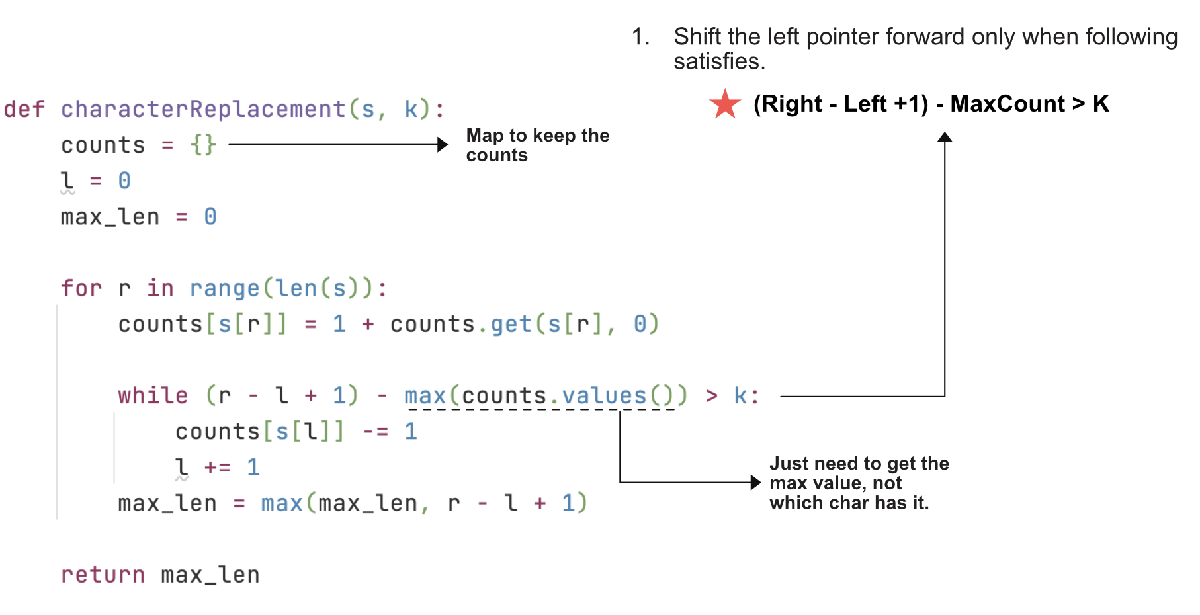Sliding Window - Longest Repeating Character Replacement
All diagrams presented herein are original creations, meticulously designed to enhance comprehension and recall. Crafting these aids required considerable effort, and I kindly request attribution if this content is reused elsewhere.
Difficulty : Easy
Map
Problem
You are given a string s and an integer k. You can choose any character of the string and change it to any other uppercase English character. You can perform this operation at most k times.
Return the length of the longest substring containing the same letter you can get after performing the above operations.
Example 1:
1
2
3
Input: s = "ABAB", k = 2
Output: 4
Explanation: Replace the two 'A's with two 'B's or vice versa.
Example 2:
1
2
3
4
5
Input: s = "AABABBA", k = 1
Output: 4
Explanation: Replace the one 'A' in the middle with 'B' and form "AABBBBA".
The substring "BBBB" has the longest repeating letters, which is 4.
There may exists other ways to achieve this answer too.
Solution
This is very similar problem as the Minimum Window Substring. We still need a map to keep track of letters in our window and we need to increment the left pointer in a while loop etc.
Start by defining three variables.
1 2 3
window_map={} l=0 max_len=0
Next, loop through the string
susing right pointerrand keep adding the letters towindow_map. Again very similar to Minimum Window Substring problem.1 2 3 4
for r in range(len(s)): # Add letter to window_map and increment # the occurrences window_map[s[r]]=1+window_map.get(s[r],0)
Now, we need the
whileloop to shrink to window, that is, increment the left pointerl. Again, this is same as Minimum Window Substring problem. The only difference is the breaking condition.Let’s skip the
whileloop condition and write the logic inside. Same concept as Minimum Window Substring problem. Remove letters from thewindow_mapusingleft pointerand keep incrementing left pointer.1 2 3
while <some logic> : window_map[s[l]] -= 1 l += 1
Now comes the main difference between the Minimum Window Substring and this problem. In the Minimum Window Substring problem, we can increment
reven ifhave !=need. So no matter ifhave==needornotwe can incrementr.However in this problem, we wont increment
runless we are allowed to, but before that let’s decode that main logic a bit more.- set
l, r = 0 - Increment
rtillwindow_len - count_of_max_repeating_char_in_that_window <= k- else: increment
luntil the above coondition is satisfied again.
- else: increment
- Keep track of
max_len
- set
Above is the core algorithm, however our code is now bit different. How we can align both together so that we can understand the pattern ?
- set
l, r = 0 - Keep incrementing
r - Increment
ltillwindow_len - count_of_max_repeating_char_in_that_window > k - Keep track of
max_len
- set
So here we just flipped the condition from
<=kto>kto move the left pointerl. Themax_lencalculation in this case however will be outside of thewhileloop.1 2 3 4 5
while ((r+1)-l ) - max(window_map.values()) > k: window_map[s[l]] -= 1 l += 1 max_len = max(max_len, r-l+1)
Visualize the Solution
Final Code
1
2
3
4
5
6
7
8
9
10
11
12
13
14
15
def longest_repeating_char_replacement(self, s: str, k: int) -> int:
window_map = {}
l = 0
max_len = 0
for r in range(len(s)):
window_map[s[r]] = 1+window_map.get(s[r], 0)
while (r-l+1)-max(window_map.values()) > k:
window_map[s[l]] -= 1
l += 1
max_len = max(max_len, r-l+1)
return max_len
print(longest_repeating_char_replacement('ABAB',2))
1
4
Runtime Complexity
The runtime will be O(n) as we are simply scanning through the array once.
